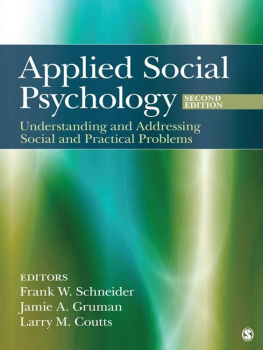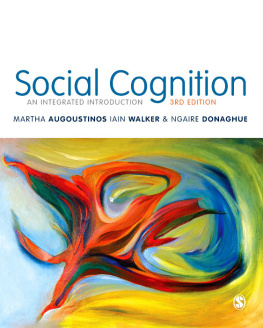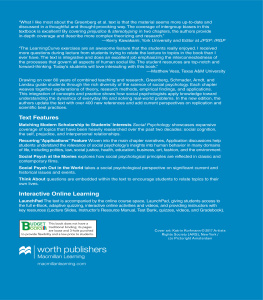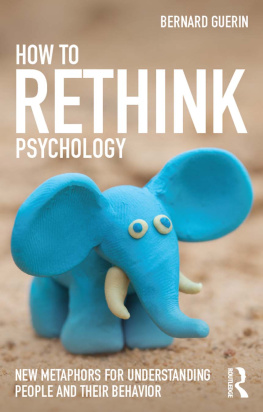SECOND EDITION
Applied Social
Psychology
To my wife Scottie and our loving parents in memory
FWS
To Tommi and Michi
JAG
To Jacinthe, Sarah, and Juliane
LMC
SECOND EDITION
Applied Social
Psychology
Understanding and Addressing
Social and Practical Problems
EDITORS
Frank W. Schneider
University of Windsor
Jamie A. Gruman
University of Guelph
Larry M. Coutts
EPSI, Inc.


FOR INFORMATION:
SAGE Publications, Inc.
2455 Teller Road
Thousand Oaks, California 91320
E-mail:
SAGE Publications Ltd.
1 Olivers Yard
55 City Road
London EC1Y 1SP
United Kingdom
SAGE Publications India Pvt. Ltd.
B 1/I 1 Mohan Cooperative Industrial Area
Mathura Road, New Delhi 110 044
India
SAGE Publications Asia-Pacific Pte. Ltd.
33 Pekin Street #02-01
Far East Square
Singapore 048763
Acquisitions Editor: Chris Cardone
Editorial Assistant: Sarita Sarak
Production Editor: Brittany Bauhaus
Copy Editor: Melinda Masson
Typesetter: C&M Digitals (P) Ltd.
Proofreader: Penelope Sippel
Indexer: Naomi Linzer
Cover Designer: Gail Buschman
Marketing Manager: Liz Thornton
Permissions Editor: Karen Ehrmann
Copyright 2012 by SAGE Publications, Inc.
All rights reserved. No part of this book may be reproduced or utilized in any form or by any means, electronic or mechanical, including photocopying, recording, or by any information storage and retrieval system, without permission in writing from the publisher.
Printed in the United States of America
Library of Congress Cataloging-in-Publication Data
Applied social psychology: understanding and addressing social and practical problems / editors, Frank W. Schneider, Jamie A. Gruman, Larry M. Coutts.2nd ed.
p. cm.
Includes bibliographical references and index.
ISBN 978-1-4129-7638-1 (pbk.)
1. Social psychology. I. Schneider, Frank W. II. Gruman, Jamie A. III. Coutts, Larry M.
HM1033.S36 2012
302dc23 2011029801
This book is printed on acid-free paper.
11 12 13 14 15 10 9 8 7 6 5 4 3 2 1
CONTENTS
Frank W. Schneider, Jamie A. Gruman, and Larry M. Coutts
Greg A. Chung-Yan and Shelagh M. J. Towson
Kenneth M. Cramer and Louise R. Alexitch
Adam Lodzinski, Michiko S. Motomura, and Frank W. Schneider
Kenneth E. Hart, David M. Ledgerwood, and Phillip A. Ianni
Philip Sullivan, Deborah L. Feltz, and Lori Dithurbide
David R. Ewoldsen and Beverly Roskos
Kathryn D. Lafreniere and Kenneth M. Cramer
Louise R. Alexitch
Larry M. Coutts and Jamie A. Gruman
David M. Day and Stphanie B. Marion
Kathryn D. Lafreniere, Stewart Page, and Charlene Y. Senn
Robert Gifford
Catherine T. Kwantes, Sherry Bergeron, and Ritu Kaushal
Ann L. Weber
Randolph A. Smith
Kenneth E. Hart and Phillip A. Ianni
PREFACE
T his textbook serves as an introduction to applied social psychology which is the branch of the field of social psychology that focuses on understanding social and practical problems and on developing intervention strategies directed at the amelioration of such problems. As editors of this second edition, as with the first edition, we have two main objectives. One objective is to produce a text for a course in applied social psychology that is compatible with the interests and abilities of students at the advanced undergraduate level. The second main objective is to share with students the promise of applied social psychology and our excitement about the field. That excitement can be traced to a considerable extent to our mutual involvement in the graduate program in applied social psychology at the University of Windsor: Frank Schneider was a co-founder of the program, Jamie Gruman earned his doctorate from the program, and Larry Coutts served as a faculty member in the program. Our excitement also stems from an awareness of the mounting evidence of the applicability of social psychological theory and knowledge to the improvement of the functioning of individuals, groups, organizations, communities, and societies with respect to a wide variety of social and practical problems.
REACTIONS TO FIRST EDITION
Not long after the publication of the first edition our initial vision for the book began to be confirmed by two formal reviews of the book (Boon, 2005; Simpson, 2005) and by the rate of its adoption as a text. Both reviewers had high praise for the book, including how well we were able to maintain consistency of writing style and organization despite the involvement of many authors. An unanticipated reward for us was the pedagogical impact the book had on the reviewers themselves. One reviewer wrote, I have a renewed enthusiasm for my field and a much deeper appreciation of the range of situations in which social psychological theory and research may be, and indeed have been, applied, and a fuller understanding of the opportunities, perhaps even the obligation, that I have, as a social psychologist, to do research that positively impacts the world (Boon, 2005, p. 251). The second reviewer wrote, This is a refreshing, well-written, inspirational text that suggests that psychology is indeed making progress in making the world a better place. Reading it has revitalized my desire to redirect my formal experimental social psychology training to solve practical problems (Simpson, 2005).
We also were encouraged by the number of instructors who adopted the book for courses in applied social psychology and related courses (applied psychology, special topics in social psychology, etc.), as well as by the feedback from the psychology editor at SAGE that Applied Social Psychology was regarded as among their more successful books. Moreover, we were pleased to learn of the books adoption in a number of lower level graduate courses, including applied social psychology and the social bases of behavior.
ORGANIZATION
As with the first edition, the book maintains a balance between social psychological theory, research, and application. The book now is formally divided into three parts. ).
The book is most appropriate for students with some course work in psychology. However, students with little or no formal background in psychology, including those in allied fields (e.g., sociology, communication studies) should feel comfortable in reading the book because of the instructional approach that it takes. The instructional features come, in particular, in the first four chapters which systematically review the basic processes of applied social psychology.
FEATURES
- Central role of intervention strategies. The content and emphases are guided by the assumption that at the core of applied social psychology is the development and implementation of intervention strategies directed at the improvement of individuals, groups, organizations, communities, and societies.
- Personal interventions. The book is unique among applied social psychology books in having chapters that focus on personal uses of social psychology which help to underscore the personal relevance and utility of the field.
Next page











